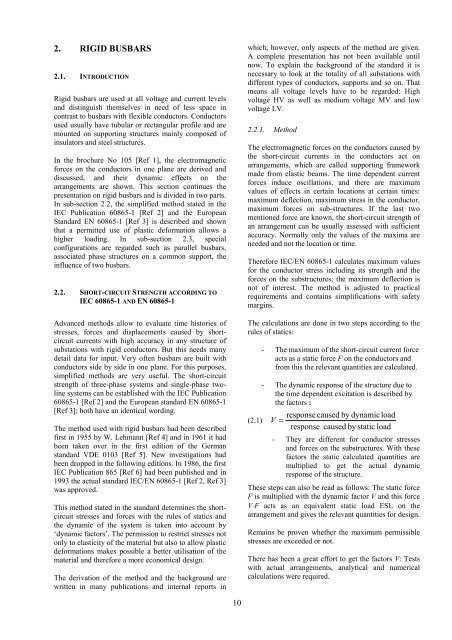The mechanical effects of short-circuit currents in - Montefiore
The mechanical effects of short-circuit currents in - Montefiore
The mechanical effects of short-circuit currents in - Montefiore
You also want an ePaper? Increase the reach of your titles
YUMPU automatically turns print PDFs into web optimized ePapers that Google loves.
2. RIGID BUSBARS<br />
2.1. INTRODUCTION<br />
Rigid busbars are used at all voltage and current levels<br />
and dist<strong>in</strong>guish themselves <strong>in</strong> need <strong>of</strong> less space <strong>in</strong><br />
contrast to busbars with flexible conductors. Conductors<br />
used usually have tubular or rectangular pr<strong>of</strong>ile and are<br />
mounted on support<strong>in</strong>g structures ma<strong>in</strong>ly composed <strong>of</strong><br />
<strong>in</strong>sulators and steel structures.<br />
In the brochure No 105 [Ref 1], the electromagnetic<br />
forces on the conductors <strong>in</strong> one plane are derived and<br />
discussed, and their dynamic <strong>effects</strong> on the<br />
arrangements are shown. This section cont<strong>in</strong>ues the<br />
presentation on rigid busbars and is divided <strong>in</strong> two parts.<br />
In sub-section 2.2, the simplified method stated <strong>in</strong> the<br />
IEC Publication 60865-1 [Ref 2] and the European<br />
Standard EN 60865-1 [Ref 3] is described and shown<br />
that a permitted use <strong>of</strong> plastic deformation allows a<br />
higher load<strong>in</strong>g. In sub-section 2.3, special<br />
configurations are regarded such as parallel busbars,<br />
associated phase structures on a common support, the<br />
<strong>in</strong>fluence <strong>of</strong> two busbars.<br />
2.2. SHORT-CIRCUIT STRENGTH ACCORDING TO<br />
IEC 60865-1 AND EN 60865-1<br />
Advanced methods allow to evaluate time histories <strong>of</strong><br />
stresses, forces and displacements caused by <strong>short</strong><strong>circuit</strong><br />
<strong>currents</strong> with high accuracy <strong>in</strong> any structure <strong>of</strong><br />
substations with rigid conductors. But this needs many<br />
detail data for <strong>in</strong>put. Very <strong>of</strong>ten busbars are built with<br />
conductors side by side <strong>in</strong> one plane. For this purposes,<br />
simplified methods are very useful. <strong>The</strong> <strong>short</strong>-<strong>circuit</strong><br />
strength <strong>of</strong> three-phase systems and s<strong>in</strong>gle-phase twol<strong>in</strong>e<br />
systems can be established with the IEC Publication<br />
60865-1 [Ref 2] and the European standard EN 60865-1<br />
[Ref 3]; both have an identical word<strong>in</strong>g.<br />
<strong>The</strong> method used with rigid busbars had been described<br />
first <strong>in</strong> 1955 by W. Lehmann [Ref 4] and <strong>in</strong> 1961 it had<br />
been taken over <strong>in</strong> the first edition <strong>of</strong> the German<br />
standard VDE 0103 [Ref 5]. New <strong>in</strong>vestigations had<br />
been dropped <strong>in</strong> the follow<strong>in</strong>g editions. In 1986, the first<br />
IEC Publication 865 [Ref 6] had been published and <strong>in</strong><br />
1993 the actual standard IEC/EN 60865-1 [Ref 2, Ref 3]<br />
was approved.<br />
This method stated <strong>in</strong> the standard determ<strong>in</strong>es the <strong>short</strong><strong>circuit</strong><br />
stresses and forces with the rules <strong>of</strong> statics and<br />
the dynamic <strong>of</strong> the system is taken <strong>in</strong>to account by<br />
‘dynamic factors’. <strong>The</strong> permission to restrict stresses not<br />
only to elasticity <strong>of</strong> the material but also to allow plastic<br />
deformations makes possible a better utilisation <strong>of</strong> the<br />
material and therefore a more economical design.<br />
<strong>The</strong> derivation <strong>of</strong> the method and the background are<br />
written <strong>in</strong> many publications and <strong>in</strong>ternal reports <strong>in</strong><br />
10<br />
which, however, only aspects <strong>of</strong> the method are given.<br />
A complete presentation has not been available until<br />
now. To expla<strong>in</strong> the background <strong>of</strong> the standard it is<br />
necessary to look at the totality <strong>of</strong> all substations with<br />
different types <strong>of</strong> conductors, supports and so on. That<br />
means all voltage levels have to be regarded: High<br />
voltage HV as well as medium voltage MV and low<br />
voltage LV.<br />
2.2.1. Method<br />
<strong>The</strong> electromagnetic forces on the conductors caused by<br />
the <strong>short</strong>-<strong>circuit</strong> <strong>currents</strong> <strong>in</strong> the conductors act on<br />
arrangements, which are called support<strong>in</strong>g framework<br />
made from elastic beams. <strong>The</strong> time dependent current<br />
forces <strong>in</strong>duce oscillations, and there are maximum<br />
values <strong>of</strong> <strong>effects</strong> <strong>in</strong> certa<strong>in</strong> locations at certa<strong>in</strong> times:<br />
maximum deflection, maximum stress <strong>in</strong> the conductor,<br />
maximum forces on sub-structures. If the last two<br />
mentioned force are known, the <strong>short</strong>-<strong>circuit</strong> strength <strong>of</strong><br />
an arrangement can be usually assessed with sufficient<br />
accuracy. Normally only the values <strong>of</strong> the maxima are<br />
needed and not the location or time.<br />
<strong>The</strong>refore IEC/EN 60865-1 calculates maximum values<br />
for the conductor stress <strong>in</strong>clud<strong>in</strong>g its strength and the<br />
forces on the substructures; the maximum deflection is<br />
not <strong>of</strong> <strong>in</strong>terest. <strong>The</strong> method is adjusted to practical<br />
requirements and conta<strong>in</strong>s simplifications with safety<br />
marg<strong>in</strong>s.<br />
<strong>The</strong> calculations are done <strong>in</strong> two steps accord<strong>in</strong>g to the<br />
rules <strong>of</strong> statics:<br />
- <strong>The</strong> maximum <strong>of</strong> the <strong>short</strong>-<strong>circuit</strong> current force<br />
acts as a static force F on the conductors and<br />
from this the relevant quantities are calculated.<br />
- <strong>The</strong> dynamic response <strong>of</strong> the structure due to<br />
the time dependent excitation is described by<br />
the factors :<br />
response caused by dynamic load<br />
(2.1) V =<br />
response caused by static load<br />
- <strong>The</strong>y are different for conductor stresses<br />
and forces on the substructures. With these<br />
factors the static calculated quantities are<br />
multiplied to get the actual dynamic<br />
response <strong>of</strong> the structure.<br />
<strong>The</strong>se steps can also be read as follows: <strong>The</strong> static force<br />
F is multiplied with the dynamic factor V and this force<br />
V⋅F acts as an equivalent static load ESL on the<br />
arrangement and gives the relevant quantities for design.<br />
Rema<strong>in</strong>s be proven whether the maximum permissible<br />
stresses are exceeded or not.<br />
<strong>The</strong>re has been a great effort to get the factors V: Tests<br />
with actual arrangements, analytical and numerical<br />
calculations were required.











